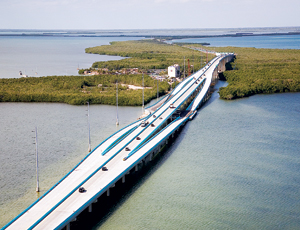An estimated $12.2 billion in federal stimulus funding will help Florida patch up some of the holes in its state budget and put thousands of Floridians to work. That was the message from Gov. Charlie Crist (R) when he hailed the passage of the federal stimulus bill in mid-February. He announced his $66.5-billion 2009-10 budget on Feb. 20.

The stimulus will add some $4.7 billion in revenue for 2009-10, effectively reducing the budget cuts that had been widely expected, according to the governor’s office. The state Legislature had held a special session in which it cut $2.5 billion to close a gap in the current year’s budget. In the past two years, the state had cut some $7 billion from its budget. Now, some $3.2 billion in stimulus funding will be used in the current fiscal year.
The Florida Dept. of Transportation will be the biggest recipient of stimulus construction dollars. Crist’s budget calls for $7.1 billion in transportation funding in 2009-10, down from the current year’s $8.2 billion. But state transportation officials estimate the stimulus will deliver an additional $1.4 billion.
FDOT had listed $6.9 billion in projects as “ready to go.” Some $1.35 billion of stimulus funds will go to highway and bridge construction, urban transit systems will receive $290million and rural transit systems will get about $20 million. An additional $5.4 million is directed to fixed-guide way systems. The stimulus also funds $50million in airport improvements.
Dave Lee, an administrator in FDOT’s office of policy planning, says the department has been coordinating with its district offices about priority projects throughout the legislative process and is still finalizing a list of stimulus projects. FDOT is using seven factors to prioritize these projects: previously deferred; tied to concurrency where development is being held up; potential to generate revenue; geographically balanced; provide congestion relief; located in economically distressed areas; and can be completed within three years.

CRIST
“We plan to make sure that we don’t lose out on any of the funds available to Florida,” Lee says. “And we hope to actually use some that other states can’t, in that use-it-or-lose-it provision.” The agency must obligate 50%of the projects within 120 days and the remaining stimulus projects within one year. Obligation indicates federal approval for a project to move forward.
FDOT, which has been a national leader in the adoption and use of design build, will likely use this delivery method for some of its stimulus projects. “That would be a good way to go on a lot of these,” Lee says. “You’re going to see a pretty good range of smaller- and bigger sized projects.”
The governor’s office and FDOT estimate that the stimulus funding will “create or retain” 24,200 jobs. Robert G. Burleson, president of the Florida Transportation Builders Association in Tallahassee, adds, “We hope to be bidding [stimulus] projects in April. [Transportation contractors] will begin hiring new people immediately.”
Some major projects are prime candidates. In Tampa, the Hillsborough County Metropolitan Planning Organization cites the $463-million Interstate 4/Crosstown Connector project as its top priority. The mile-long project, which has rights-of-way and environmental permits, would connect I-4 with the Port of Tampa and the Selmon Crosstown Expressway. In Orlando, officials hope to fund a stalled 61.5-mile, $1.2-billion commuter rail project.
The stimulus comes on the heels of Crist’s Accelerate Florida program. Enacted last fall, it moved up the start dates between one and five months for 179 projects totaling $1.4 billion.


Post a comment to this article
Report Abusive Comment